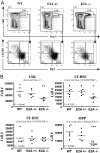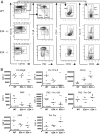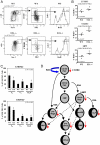E2A proteins maintain the hematopoietic stem cell pool and promote the maturation of myelolymphoid and myeloerythroid progenitors
- PMID: 19181846
- PMCID: PMC2644141
- DOI: 10.1073/pnas.0808866106
E2A proteins maintain the hematopoietic stem cell pool and promote the maturation of myelolymphoid and myeloerythroid progenitors
Abstract
Hematopoiesis is a tightly controlled process maintained by a small pool of hematopoietic stem cells (HSCs). Here, we demonstrate that the LT-HSC, MPP, premegakaryocytic/erythroid, Pre CFU-E, Pre GM, MkP, and granulocyte-macrophage compartments were all significantly reduced in E2A-deficient bone marrow. Despite a severe depletion of erythroid progenitors, the erythrocyte and megakaryocyte compartments were equivalent in E2A-deficient bone marrow as compared with wild-type mice. E2A-deficient HSCs also failed to efficiently maintain the HSC pool on serial transplantation, and we demonstrate that the E2A proteins regulate cell cycle progression of HSCs by regulating the expression of p21(Cip1), p27(Kip1), and the thrombopoietin receptor, known regulators of HSC self-renewal activity. Based on these observations, we propose that the E2A proteins promote the developmental progression of the entire spectrum of early hematopoietic progenitors and to suppress an erythroid specific program of gene expression in alternative cell lineages. Last, the data mechanistically link E2A, cell cycle regulators, and the maintenance of the HSC pool in a common pathway.
Conflict of interest statement
The authors declare no conflict of interest.
Figures



References
-
- Spangrude GJ, Heimfeld S, Weissman IL. Purification and characterization of mouse hematopoietic stem cells. Science. 1988;241:58–62. - PubMed
-
- Akashi K, Traver D, Miyamoto T, Weissman IL. A clonogenic common myeloid progenitor that gives rise to all myeloid lineages. Nature. 2000;404:193–197. - PubMed
-
- Kondo M, Weissman IL, Akashi K. Identification of clonogenic common lymphoid progenitors in mouse bone marrow. Cell. 1997;91:661–672. - PubMed
-
- Adolfsson J, et al. Identification of Flt3+ lympho-myeloid stem cells lacking erythro-megakaryocytic potential a revised road map for adult blood lineage commitment. Cell. 2005;121:295–306. - PubMed
-
- Pronk CJ, et al. Elucidation of the phenotypic, functional, and molecular topography of a myeloerythroid progenitor cell hierarchy. Cell Stem Cell. 2007;1:428–442. - PubMed
Publication types
MeSH terms
Substances
Grants and funding
LinkOut - more resources
Full Text Sources
Medical
Molecular Biology Databases
Miscellaneous

